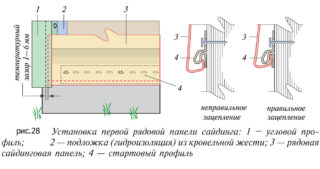Installation of siding with the installation of H-planks begins from the center of the facade, which leads to an overspending of material, since there is nowhere to do with the trim panels of a rather large size. The siding dock without a tie bar is used as an overlay of vinyl or metal end faces. Joints of this kind are invisible if the overlay is placed in the light so that the top part does not create shadows.
Features of overlapping siding installation
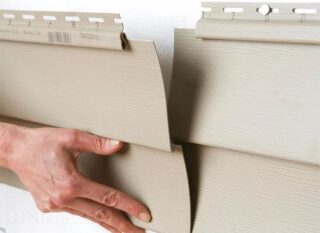
Vinyl siding panels have a significant coefficient of expansion, so the material shrinks in cold weather, and expands when heated from the sun or on a hot afternoon.
Features of siding cover without the use of a docking element:
- If the overlap of the strips is less than 25 mm in length, a gap will appear under certain conditions. Snow, rain will fall into it, which will destroy the material of the building wall.
- A certain temperature gap is carried out between the guiding element of the sheathing and the panel itself, in addition to observing the size of the overlap. When installed in the summer, such a gap is made 5 - 6 mm, in winter in frost they leave up to 15 mm. This will help maintain the integrity of the joint between the rows of panels.
- The overlap joint has a certain thickness, so siding without a docking strip is mated over the whole area below the underlying strip. From above, the joint is also covered with an uncut section of the panel.
From a certain angle, the joint of the overlapping panels becomes visible. As temperatures change, the connection will always be less or more noticeable. The installation of the upper strip is done from the shadow side in relation to the lower flat element.
The advantages of overlapping docking:
- saving materials (H-bars and hardware for them);
- connecting strips violate the integrity of the walls, "cut" them into separate sections, therefore, without these elements, the facade looks harmonious;
- The H-plank is not always exactly matched in color, and attracts more attention to individual sections of the walls, and siding without joints is always of the same shade.
Some argue that the savings on the H-profile are doubtful, since the consumption of panels for the joint plate increases. But when connected to the strips of waste, much more is obtained due to the fact that they are small for installation in the proposed segment, and they still do not fit anywhere else.
There are also disadvantages to overlapping. If the installation technology is violated, the panels will skew and the joints will be conspicuous due to unevenness. Neglecting or insufficiently dimensioned expansion gaps will cause the panels to ripple, so the siding joints may open up.
Cases of the need for overlapping siding
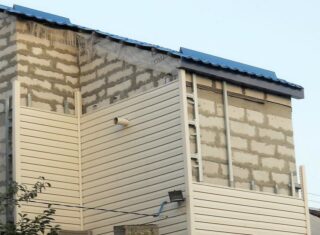
The material is produced with imitation of various natural materials, for example, wood, stone, brickwork, fabric, straw. If you put dividing strips on the facade, the decoration goal will not be achieved.
Cases of overlap application when joining siding panels:
- In areas where pipelines and cables exit the wall, when dismantling and re-installation are associated with additional costs, difficulties, or even impossible.
- Creation of imitation of a solid layer in the form of masonry basement, walls made of wood, brick.
- Acceleration of cladding work, since the process of installation, alignment and fixation of the docking element is excluded.
Docking with an overlap is not always justified, for example, in the case of a small length of walls, when standard siding strips are enough to create a finish. The length of ordinary elements is about four meters, and the width is 0.3 m. Strips without joints are used for facing small verandas, gazebos, garages, sheds, guest houses.
If the house is located near the motorway, there will be a lot of dust around. It will hammer into the connecting slots and show the seams.
Rules for joining material without a connecting strip
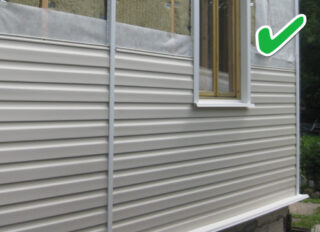
Siding panels are joined in height into the lock. The lower strip is snapped onto the starting element until it clicks, fixed with self-tapping screws in the slots. The upper strip is snapped onto the previous one, bringing it into a special relief and also fixed with self-tapping screws.
Lap joint rules:
- If in this area there is a joining of panels along the length, the two overlapping strips snap together simultaneously on the lower strip.
- The technology assumes that the next joint along the length can no longer be located above the previous seam, it is done a little further.
- It will not be possible to snap the upper joined panels over the lower ones, which are also overlapped.
- It is impossible to nail down metal or vinyl plates with nails through and through, for this there are oval slots at the top of the panel for fixing to the crate.
The cladding is mounted at a positive temperature for the convenience of workers. But the technology also provides for installation at minus indicators. No wet processes are provided, the material itself and the frame of the sheathing can withstand negative temperatures. It is not recommended to work at readings below -10 ° С.
Overlap siding installation technology
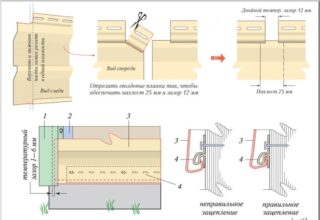
Installation of panels without a special strip occurs correctly if the work is carried out according to technology. The panels are mounted evenly, the fixing points are positioned at the same level to avoid distortions. The batten can be omitted if the vertical railing of the building is perfectly aligned. Such cases are rare, so they use a frame to smooth the plane.
The steps are performed in the following order:
- the crate is fixed to the walls, the correct installation is checked with a level, a plumb line;
- Styrofoam, penoplex are inserted into the gaps of the frame, the joints are sealed with foam;
- mount the starting bar at the bottom of the building, on the plinth, around the windows, on the pediment;
- make an overlap siding installation without an H-profile, staggering the connection.
The upper strip is wound from top to bottom by 25 mm so that it exactly continues the previous one, they are aligned horizontally.
Installation of the first panel
Installation rules:
- a long strip is fastened with self-tapping screws, starting from the center, moving evenly to the two ends;
- hardware does not fix tightly for temperature compensation;
- at negative ambient temperatures leave a gap between the batten and the profile up to 15 mm;
- panels are placed, starting from door openings, gates, so that the joints are removed from them as far as possible.
Rows of stripes are placed sequentially from bottom to top. If the panels are installed vertically, start from right to left. As a result, a uniform plane is obtained in which connections made without a bar are invisible. Sections with such a joint are assembled in different quadratures.
Before installing the last element, a finish bar is installed. Panel locks are cut at an angle to also provide clearance for temperature compensation.
Installation in difficult places and around openings
When joining the ends of the strips around the windows, perform the following actions:
- measure the size between the bottom of the lock of the end strip and the bottom of the upper lock of the previous panel;
- add 15 mm to the resulting distance to bring the end of the siding into the finish bar;
- the panel is cut to the required size under the window;
- using a punch, make new ears-holes every 200 mm along the finished part.
The ears are positioned so that they are on the front side of the panel. They try to calculate the length of the panels so that there is no joining in this place or nearby without the use of an H-profile.
Overlap siding on gables
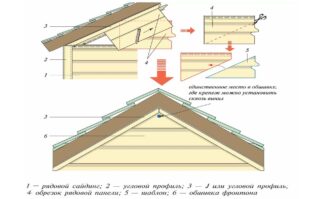
A J-profile is placed on the inclined sides; for reliability, it is fixed after 200 - 300 mm. If short panels are used, they are pre-laid on top of each other to ensure joining. Then cut at an angle to the shape of the pediment. Every 2 subsequent strips are measured out after installing the underlying ones.
At the top, the edge is inserted into the finishing strip, and fastened to the crate with nails. They can be driven through the body of the siding strip. This may only be done on the pediment and only in such a place.

